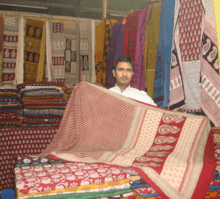Bagh, Dhar
Bagh is a census town in Dhar district in the state of Madhya Pradesh, India. It is known for the Bagh Caves, which are late 4th- to 6th-century Buddhist rock-cut chambers with murals. The name of the town stems from the caves - according to local legend there were living tigers (bagh in several languages of India) in these abandoned Buddhist caves.[1]
Bagh | |
|---|---|
city | |
 Bagh Location in Madhya Pradesh, India  Bagh Bagh (India) | |
| Coordinates: 22.37°N 74.77°E | |
| Country | |
| State | Madhya Pradesh |
| District | Dhar |
| Government | |
| • Type | Sarpanch |
| • Body | Gram panchayat |
| Elevation | 240 m (790 ft) |
| Population (2001) | |
| • Total | 7,415 |
| Languages | |
| • Official | Hindi |
| Time zone | UTC+5:30 (IST) |
| PIN | 454221 |
| Telephone code | 07297 |
| ISO 3166 code | IN-MP |
| Vehicle registration | MP-11 |
| Spoken Languages | Hindi, Bhili, Bhilali, Nimadi, English, Khatri |
The town is also known for a type of block prints on fabric, known as Bagh prints.
History
In 1982, a hoard of 27 inscriptions issued by the Maharajas of Valkha was discovered at Risawala near Bagh. The inscriptions were issued from a place known as Valkha, which has led to suggestions that the name "Bagh" is derived from "Valkha". The inscriptions are dated to the years 38-134 of an unspecified calendar era. Historians D. C. Sircar and R. C. Majumdar theorized that the Maharajas of Valkha were subordinates to the Guptas, and the calendar era used in their inscription is the Gupta era starting from 319 CE.[2] Thus, the Maharajas of Valkha can be dated to 4th and 5th centuries CE.[3]
The next known ruler of the region is Maharaja Subandhu of Mahishmati. His Bagh Caves inscription is dated 167 (486 CE, assuming Gupta era).[3][4] Art historian Walter M. Spink has identified Subandhu as the prince Vishruta mentioned in Dashakumaracharita. According to his theory, Subandhu or Vishruta was a Gupta prince, who established the dynasty that later came to be known as Kalachuri.[5][6]
Transport Connectivity
By Train
Nearest Railway stations are Dahod 100 km., Indore 150 km., Meghnagar 104 km., Ratlam 150 km, Khandwa 220 km.
By Road
Bagh is well connected to Indore by road and Daily Bus Services.
Bagh Printing
The Khatris are a community whose inward beings dance the Sufi way. They came under the influence of a sufi man and it stuck a long lasting chord. Originally Ajrakh printers they ventured into places to sell their fabrics and their enterprising ways kept them upfloat. From Larkana in Sind (today’s Pakistan) to Pali, to the Marwadi Thar, to Manawar in Madhya Pradesh, their journey came to a stop and they settled down in Bagh in 1962 as they saw their grandfather and uncles returning back to their ancestral land (Karachi, Pakistan) during Partition[7]
Bagh is located at 22.37°N 74.77°E.[8] It has an average elevation of 240 metres (787 feet).
Demographics
As of 2001 India census,[9] Bagh had a population of 7415. Males constitute 51% of the population and females 49%. Bagh has an average literacy rate of 63%, higher than the national average of 59.5%; with 57% of the males and 43% of females literate. 16% of the population is under 6 years of age.
Notable people from Bagh
- Abdul Kadar Khatri (1961 - 2019) Master Craftsman[10][11]
- Mohammed Yusuf Khatri, printer
- Mohammed Bilal Khatri, printer[12][13][14][15]

References
- "Bagh Caves - rock cut Buddhist temples". Retrieved 23 April 2010.
- Shiv Kumar Tiwari 2002, pp. 63-64.
- Archana Verma 2007, p. 23.
- Walter M. Spink 2005, p. 37.
- Walter M. Spink 2005, pp. 153-154.
- Sara L. Schastok 1985, p. 97.
- https://gaatha.org/igaatha/details_craft/Crafts/Bagh-print-craft/Bagh-block-print-madhya-pradesh
- Falling Rain Genomics, Inc - Bagh
- "Census of India 2001: Data from the 2001 Census, including cities, villages and towns (Provisional)". Census Commission of India. Archived from the original on 16 June 2004. Retrieved 1 November 2008.
- "Bagh artist Abdul Khatri bags UNESCO 2018 award in Qatar | Bhopal News - Times of India". The Times of India.
- Pioneer, The. "Bagh artisan Abdul Kadar Khatri bags UNESCO, world craft council award". The Pioneer.
- "Russia awards diploma to Bagh print artist Bilal Khatri". The free press journal. 5 October 2014. Retrieved 10 January 2015.
- "Vishwakarma award for craftsmen". Times of India. 25 November 2012. Retrieved 11 January 2015.
- "Celebrating creativity". The Hindu. 21 January 2015. Retrieved 21 January 2015.
- "Artist Bilal Khatri represents MP for Bagh print in China". The free press journal. 4 November 2014. Retrieved 11 January 2015.
Bibliography
- Archana Verma (2007). Cultural and Visual Flux at Early Historical Bagh in Central India. Oxford: Archaeopress. ISBN 9781407301518.CS1 maint: ref=harv (link)
- Sara L. Schastok (1985). The Śāmalājī Sculptures and 6th Century Art in Western India. BRILL. ISBN 9789004069411.CS1 maint: ref=harv (link)
- Shiv Kumar Tiwari (2002). Tribal Roots of Hinduism. Sarup & Sons. ISBN 9788176252997.CS1 maint: ref=harv (link)
- Walter M. Spink (2005). Ajanta: The end of the Golden Age. BRILL. ISBN 9789004148321.CS1 maint: ref=harv (link)